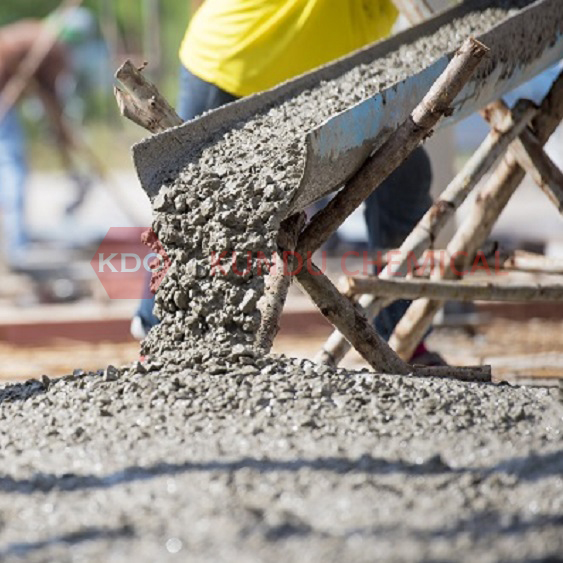- Time:2023/7/13Posted:SHANDONG KUNDU CHEMICAL CO.,LTD.
In recent years, with the continuous development of the construction industry and the continuous emergence of high-rise buildings, the demand for concrete is increasing, the strength grade is higher and higher, and the quality requirements are also higher and higher.
Polycarboxylate-based (PCE) superplasticizeris a kind of concrete admixture with high water reduction rate and low slump loss.
It can greatly increase the rheological properties of fresh concrete while improving the compressive strength of hardened concrete and keeping the water consumption unchanged.
It plays a vital role in the workability of fresh concrete and hardened concrete. It also ensures the continuity of engineering construction, greatly shortens the construction period, promotes the development of fluid concrete technology and pumping pouring, and accelerates the development of commercial concrete.1、 The function of PCE (PolyCarboxylate Ester)

Polycarboxylate superplasticizer plays four main roles in concrete mixtures: first, in order to improve the pouring performance of concrete, improve the workability of concrete without changing the composition of concrete;
Second: under the given working conditions, reduce the water cement ratio of mixing water and concrete, and improve the strength and durability of concrete;
Third, under the condition of ensuring the pouring performance and strength of concrete, reduce the amount of water and cement, and reduce the factors that cause the initial defects of concrete, such as creep, dry shrinkage, cement hydration heat, etc;
Fourth: the role of polycarboxylate superplasticizer in high-grade concrete is irreplaceable by other admixtures. In concrete above C50 standard, the workability of concrete is difficult to achieve by other admixtures. It is predicted that the improvement of concrete process performance and the breakthrough of concrete grouting technology in the future will mainly rely on high-quality superplasticizer based on polycarboxylate polymers (PCE).
2、 The performance of PCEs :Main technical characteristics of PCE polymer:
1. The content of polycarboxylic acid superplasticizer is low, and the water reduction rate is high.
The content of polycarboxylic acid superplasticizer accounts for 0.80% - 1.25% of the cementitious material, and the water reduction rate can reach (20% - 35)%. When used in combination with fly ash, the water binder ratio is low, and it is suitable for the preparation of medium and high strength high-performance concrete.
2. The concrete has large fluidity and low slump loss. Due to the good dispersion stability of polycarboxylate superplasticizer, the large fluidity concrete (slump ≥ 18omm) prepared by polycarboxylate superplasticizer has low time loss, basically no slump loss in one hour, and the second hour loss is less than 15%, which makes up for the defects of concrete prepared by common naphthalene superplasticizer, such as high slump loss and easy bleeding, When used in combination with fly ash, excellent fluidity can be obtained with a small amount of water reducer, which can meet the process requirements of commercial concrete production, especially for pumped concrete, pipe plugging is not easy to occur.3. It has good adaptability to cementitious materials. In engineering practice, the cement produced by different manufacturers is used to prepare pumping concrete, and a large amount of fly ash is mixed at the same time. After the polycarboxylic acid superplasticizer is mixed, it has good compatibility with different cements, and there is no obvious bleeding segregation, which hinders the growth of concrete strength. Because of its high water reduction rate, it is suitable to be used with fly ash, reducing the shrinkage of fly ash concrete, It also significantly improves the pumpability of concrete and improves the durability of concrete. When the strength of concrete is the same, the dosage of cement increases, the dosage of water reducing agent increases slightly, the water binder ratio decreases, and the strength of concrete increases; For concrete with different design strength grades, the dosage of water reducing agent increases slightly with the increase of the dosage of cementitious materials, the water binder ratio decreases, and the strength of concrete increases accordingly, but the workability of concrete remains stable on the whole, and the slump can reach (180-240) mm.
3、 Some influencing factors of polycarboxylic acid water reducer in concrete1. cement.
a. Influence of mineral composition of cement
The shrinkage rate of C3A, C3S, C2S and C4AF in Portland cement is C3A>C3S=C2S>C4F.
The increase of C3A and C3S content in cement clinker will increase the self shrinkage and dry shrinkage of concrete and increase the chance of cracking. C3A has the highest calorific value, and high hydration heat leads to accelerated slump loss of concrete.b. Influence of cement fineness
Increasing the specific surface area of cement is to increase the hydration rate, so as to improve the early strength of concrete. However, under the condition of grinding, most cement increase fine particles and increase the early hydration heat release, which has no function to improve the late strength. Moreover, the greater the fineness of cement, the worse the frost resistance of concrete and the lower the tensile strength.
More importantly, the improvement of cement fineness makes the compatibility between cement and high-efficiency water reducer worse. With the increase of cement fineness, the saturation point of superplasticizers dosage is greatly increased, and the dosage of superplasticizer required to reduce the loss of concrete slump is also greatly increased.
c. Influence of gypsum form on compatibility between water reducer and cementDifferent forms of gypsum make little difference in the product inspection of the produced cement according to the cement standard, but there will be different situations when only adding water reducer, which is due to the different solubility of reducing sugar and polyol to dihydrate gypsum, anhydrite (anhydrite) and fluorogypsum.
d. Effect of soluble alkali
Many studies have proved that the sulfate of alkali in cement, that is, soluble alkali, has a very important impact on the adaptability of additives to cement. Studies have shown that when the C3A mass fraction is not higher than 8% and the soluble alkali content of cement is high, the workability of concrete is good and the slump loss is low. When the soluble alkali is very low, the workability of concrete will lose quickly. For cement with low soluble alkali content. Increasing the content of superplasticizer can get a large initial slump, but the loss is still very fast. When a little more is added above the saturation point, the precipitation and bleeding will be significantly increased.
e. Influence of other factors of cement
Factors such as cement temperature, cement aging time, dosage, filler type and dosage will affect the working performance of concrete. The higher the temperature of cement, the worse the plasticizing effect of water reducing agent.2. Fly ash
Fly ash mainly changes the workability of concrete. Due to the fine particles, it mainly fills the voids of cement, and some crystal beads play the role of ball and increase the fluidity. With the increase of the amount of fly ash, the quality of fly ash on the market is uneven. Generally, the concrete below C50 in the mixing plant is grade II, and the concrete above C50 is grade I. due to the shortage of fly ash, many commercial concrete uses grade III fly ash or even raw ash. Due to the large fineness of grade III fly ash and raw ash, high loss on ignition and high water storage, the workability of concrete is poor, and the strength of concrete is reduced.3. Mineral powder
Granulated blast furnace slag powder can increase the initial fluidity of the slurry and reduce the fluidity loss. Mainly due to different manufacturers, different chemical compositions and fineness lead to different water requirements of mineral powder and different contributions to the strength of concrete.
4. Sand and stone
The main effects on PCE-based superplasticizers water reducer are:
(1) the content of sand is high, and the mud component in the concrete adsorbs the water reducer, resulting in large loss of concrete. The high fineness modulus of the water reducer mainly affects the workability of concrete, and the water absorption of sand leads to the water consumption of concrete;
⑵ mud content, mud block content, particle size and stone powder content of stonesThe particle size in the stone determines the water consumption. The content of stone powder has a great impact on the workability of concrete, mainly changing the composition of powder below 0.315mm in concrete, affecting the workability of concrete.
4、 Conclusion
In short, cement, fly ash, mineral powder, coarse and fine aggregates in concrete will affect the adaptability of polycarboxylic acid water reducer, which in turn affects the performance and quality of concrete final products. Therefore, the compatibility of an admixture with the various components it serves must be designed according to the site conditions, so that qualified materials can finally produce qualified concrete. Polycarboxylate superplasticizer, as a concrete admixture with high water reduction rate and small slump loss, plays a very important role. It can improve the workability of concrete, improve the strength and rheological properties of concrete, thus reducing the difficulty of concrete construction in many building structures and ensuring the safety of the structure. Therefore, it will play a great role in the construction industry and produce good benefits.





